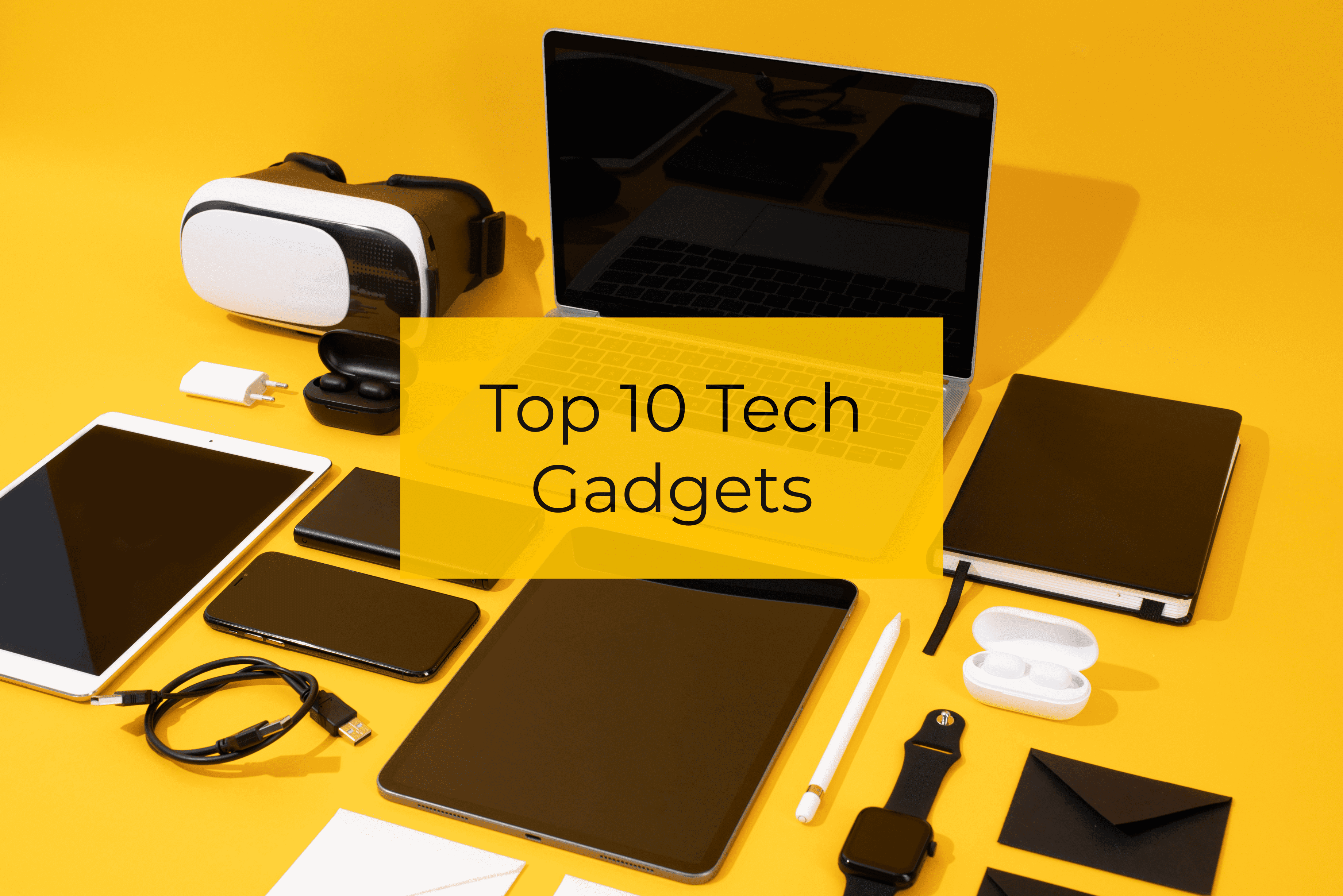
In the fast-paced realm of technology, each passing year brings forth an array of groundbreaking innovations that reshape the way we live, work, and interact with the world around us. As we step into 2024, the anticipation for cutting-edge top 10 tech gadgets and advancements reaches new heights. From revolutionary augmented reality experiences to the promise of quantum computing, the tech landscape of 2024 holds immense promise and excitement.
In this blog post, we delve into the realm of the future, exploring the top 10 tech gadgets to watch out for in 2024. These devices represent the forefront of innovation, offering glimpses into a future where technology seamlessly integrates into every facet of our lives. Join us as we embark on a journey through the realms of augmented reality, quantum computing, foldable smartphones, autonomous vehicles, wearable health tech, 5G infrastructure, home automation systems, sustainable tech innovations, and AI-powered assistants. Let’s unravel the marvels that await us in the year 2024 and beyond.
Augmented Reality (AR) Glasses
Description of the latest advancements in AR technology
Augmented Reality (AR) technology has undergone remarkable advancements in recent years, blurring the lines between the digital and physical worlds. In 2024, AR continues its evolution, offering immersive experiences that transcend traditional boundaries. The latest advancements in AR technology boast enhanced graphics rendering, improved tracking capabilities, and seamless integration with real-world environments. These developments pave the way for more immersive and realistic AR experiences than ever before.
Introduction to AR glasses and their potential applications
AR glasses, also known as smart glasses, are wearable devices equipped with AR technology that overlays digital content onto the user’s field of view. These glasses hold immense potential across various industries and applications. In 2024, AR glasses will find utility in fields such as education, healthcare, manufacturing, gaming, and more. They enable users to interact with digital information while maintaining situational awareness, revolutionizing how we perceive and interact with our surroundings.
Highlighting key features and benefits of top AR glasses releasing in 2024
Several top AR glasses are poised for release in 2024, each boasting innovative features and capabilities. These glasses offer high-resolution displays, advanced gesture recognition, voice commands, and lightweight designs for prolonged wear. Moreover, they facilitate seamless integration with smartphones and other devices, enhancing connectivity and functionality. The benefits of these AR glasses extend beyond entertainment, empowering users with enhanced productivity, improved learning experiences, and new avenues for creativity. As AR technology continues to mature, AR glasses hold the potential to transform how we perceive and interact with the world around us, ushering in a new era of augmented reality experiences.
Read More: The Basics of Digital Marketing
Quantum Computing Devices
Explanation of quantum computing and its significance
Quantum computing represents a paradigm shift in computational power, leveraging the principles of quantum mechanics to perform complex calculations at speeds unimaginable with classical computers. Unlike traditional binary systems that use bits to represent information as either 0 or 1, quantum computers utilize quantum bits or qubits, which can exist in multiple states simultaneously. This inherent parallelism enables quantum computers to tackle complex problems exponentially faster than classical computers. The significance of quantum computing lies in its potential to revolutionize fields such as cryptography, drug discovery, optimization, and machine learning, unlocking new possibilities that were previously out of reach.
Overview of quantum computing devices set to debut in 2024
In 2024, the quantum computing landscape is poised for significant advancements, with several leading companies and research institutions poised to unveil groundbreaking quantum computing devices. These devices range from cloud-based quantum processors accessible via the internet to on-premises quantum computers tailored for specific applications. Leveraging innovations in qubit coherence, error correction, and quantum networking, these devices promise unprecedented computational power and scalability. Furthermore, advancements in cryogenic cooling and control systems ensure the reliability and stability of quantum operations, paving the way for practical applications in real-world scenarios.
Discussing potential impacts on various industries
The potential impacts of quantum computing span across a myriad of industries, heralding transformative changes in sectors ranging from finance and healthcare to logistics and cybersecurity. In finance, quantum algorithms enable rapid portfolio optimization, risk assessment, and pricing modeling, revolutionizing investment strategies and financial markets. In healthcare, quantum computing accelerates drug discovery processes, simulates molecular interactions, and enhances personalized medicine initiatives, leading to breakthroughs in disease treatment and prevention. Additionally, quantum computing enhances supply chain optimization, route planning, and logistics management, driving efficiency gains and cost reductions in transportation and logistics sectors. Moreover, quantum-resistant cryptography safeguards sensitive data and communications against emerging threats, ensuring the security and integrity of digital ecosystems. As quantum computing continues to mature, its profound impacts will reshape the competitive landscape and redefine the boundaries of innovation across various industries, unlocking new possibilities for progress and prosperity.
Read More: Effective Strategies for Social Media Marketing
Foldable Smartphones
Rise of foldable smartphone technology
Foldable smartphones represent a remarkable evolution in mobile device design, offering users the flexibility of a larger screen size without sacrificing portability. Since their inception, foldable smartphones have captured the imagination of tech enthusiasts and consumers alike, heralding a new era of innovation in the mobile industry. The rise of foldable smartphone technology is driven by advancements in flexible display technologies, hinge mechanisms, and durability enhancements. These devices cater to users’ desire for multitasking capabilities, enhanced productivity, and immersive multimedia experiences, positioning foldable smartphones as a disruptive force in the smartphone market.
Comparison of leading foldable smartphone models releasing in 2024
In 2024, several leading smartphone manufacturers are set to introduce new iterations of foldable smartphones, each boasting unique designs and features. Among the anticipated models are the latest offerings from industry giants such as Samsung, Huawei, Xiaomi, and Motorola. These foldable smartphones vary in form factors, with options ranging from clamshell-style devices to book-like designs and tri-fold configurations. Key considerations for comparison include display size and resolution, hinge durability, camera capabilities, processing power, and software optimization. By evaluating these factors, consumers can make informed decisions based on their preferences and usage requirements.
Exploring unique features and advantages
Foldable smartphones offer a range of unique features and advantages that set them apart from traditional smartphone designs. One notable advantage is the ability to seamlessly transition between compact and expanded modes, providing users with greater flexibility and versatility in how they interact with their devices. Additionally, foldable smartphones enable multitasking by allowing users to run multiple apps simultaneously or split the screen for enhanced productivity. Moreover, the larger screen real estate enhances multimedia experiences, such as gaming, video streaming, and content creation, delivering immersive and engaging visuals. Furthermore, foldable smartphones often incorporate innovative camera setups, advanced biometric authentication methods, and 5G connectivity, further enhancing their appeal and functionality. As foldable smartphone technology continues to mature, manufacturers are poised to push the boundaries of innovation, delivering devices that redefine the smartphone experience and shape the future of mobile computing.
Read more: Power of Content Marketing
Autonomous Vehicles
Current state of autonomous vehicle technology
Autonomous vehicle technology has made significant strides in recent years, propelled by advancements in artificial intelligence, sensor technology, and machine learning algorithms. Today, semi-autonomous vehicles equipped with features like adaptive cruise control and lane-keeping assistance are increasingly common on the roads. However, fully autonomous vehicles capable of navigating without human intervention are still in the testing phase. Companies like Tesla, Waymo, and General Motors’ Cruise are leading the charge in developing and testing autonomous driving systems, conducting extensive real-world and simulated testing to improve safety and reliability.
Preview of groundbreaking autonomous vehicles expected in 2024
In 2024, the automotive industry is poised to witness the debut of groundbreaking autonomous vehicles that push the boundaries of self-driving technology. These vehicles will feature advanced sensor suites, including LiDAR, radar, and cameras, coupled with powerful onboard computers capable of processing vast amounts of data in real-time. Companies are striving to achieve higher levels of autonomy, aiming for fully driverless vehicles capable of operating in diverse environments and challenging conditions. These next-generation autonomous vehicles promise to revolutionize transportation, offering safer, more efficient, and convenient mobility solutions for individuals and businesses alike.
Discussion on safety, regulations, and societal implications
As autonomous vehicles inch closer to widespread adoption, concerns surrounding safety, regulations, and societal implications come to the forefront. Safety remains a paramount concern, as autonomous vehicles must demonstrate a level of reliability and predictability comparable to human drivers to gain public trust. Additionally, regulatory frameworks governing autonomous vehicle deployment vary across jurisdictions, posing challenges for widespread implementation. Policymakers grapple with issues such as liability, insurance, data privacy, and infrastructure readiness as they seek to ensure the safe integration of autonomous vehicles into existing transportation systems.
Moreover, the widespread adoption of autonomous vehicles has far-reaching societal implications, including potential job displacement in industries reliant on driving, changes in urban planning and infrastructure, and shifts in consumer behavior and mobility patterns. Addressing these complex challenges requires collaboration between industry stakeholders, policymakers, and the public to ensure that autonomous vehicles deliver on their promise of safer, more efficient, and sustainable transportation for all.
Wearable Health Tech
Importance of wearable health tech for personal wellness
Wearable health technology has emerged as a crucial tool for promoting personal wellness and empowering individuals to take proactive control of their health. These devices, worn on the body or integrated into clothing and accessories, offer real-time monitoring of vital signs, activity levels, and other health metrics. By providing continuous feedback and insights, wearable health tech enables users to track their progress, set goals, and make informed decisions about their lifestyle habits. From monitoring fitness and sleep patterns to managing chronic conditions and stress, wearable health tech plays a pivotal role in fostering healthier and more active lifestyles.
Review of innovative wearable health devices launching in 2024
In 2024, the wearable health tech market is set to witness the introduction of a new wave of innovative devices that push the boundaries of health monitoring and diagnostics. Leading manufacturers such as Apple, Fitbit, Garmin, and Samsung are expected to unveil next-generation wearable devices with enhanced features and capabilities. These devices incorporate advanced sensors, AI algorithms, and machine learning techniques to deliver more accurate and actionable insights into users’ health and wellness. From smartwatches and fitness trackers to smart clothing and biosensing wearables, the range of options available to consumers continues to expand, catering to diverse needs and preferences.
Highlighting advancements in health monitoring and diagnostics
Advancements in wearable health tech are driving significant improvements in health monitoring and diagnostics, enabling earlier detection of health issues and more personalized interventions. In 2024, wearable devices are poised to offer enhanced capabilities for monitoring a wide range of health parameters, including heart rate, blood pressure, blood glucose levels, and ECG readings. Moreover, these devices leverage sophisticated algorithms to analyze data trends over time, identify patterns, and provide actionable recommendations for improving health outcomes. Additionally, wearable health tech is increasingly integrated with telemedicine platforms, enabling remote monitoring and virtual consultations with healthcare providers, especially in underserved communities or during times of crisis. As wearable health technology continues to evolve, it holds the promise of transforming healthcare delivery, empowering individuals to lead healthier lives, and ultimately reducing the burden of chronic diseases on society.
5G Infrastructure
Impact of 5G technology on connectivity and communication
5G technology represents a monumental leap forward in connectivity and communication, offering unprecedented speed, capacity, and reliability compared to previous generations of wireless networks. With significantly lower latency and higher data transfer rates, 5G enables seamless connectivity for a wide range of devices, applications, and services. This technology facilitates faster download and upload speeds, smoother streaming of high-definition content, and more responsive gaming experiences. Moreover, the enhanced network capabilities of 5G lay the foundation for transformative technologies such as augmented reality (AR), virtual reality (VR), and real-time collaboration tools, revolutionizing how we communicate, collaborate, and interact with digital content.
Overview of upcoming 5G infrastructure advancements in 2024
In 2024, the rollout of 5G infrastructure is expected to accelerate, ushering in a new era of connectivity and innovation. Telecom companies and infrastructure providers are investing heavily in expanding and enhancing 5G networks to meet growing demand and support emerging use cases. These advancements include the deployment of additional 5G base stations, the implementation of advanced antenna technologies such as massive MIMO (Multiple-Input Multiple-Output), and the optimization of network architecture for improved coverage and capacity. Moreover, the integration of edge computing capabilities into 5G infrastructure enables faster processing of data and lower latency for latency-sensitive applications, unlocking new possibilities for edge computing services and applications.
Discussing potential implications for IoT, smart cities, and beyond
The widespread adoption of 5G technology holds significant implications for various sectors, including the Internet of Things (IoT) and smart cities initiatives. With its high-speed, low-latency connectivity, 5G enables the proliferation of IoT devices and sensors, facilitating real-time data collection, analysis, and decision-making across industries such as healthcare, manufacturing, transportation, and agriculture. In smart cities, 5G infrastructure serves as the backbone for interconnected systems and services, enabling efficient traffic management, enhanced public safety, and sustainable urban development. Furthermore, 5G opens up opportunities for innovative applications such as autonomous vehicles, smart grid management, remote healthcare monitoring, and immersive multimedia experiences. By leveraging the capabilities of 5G technology, organizations and communities can unlock new levels of efficiency, productivity, and quality of life, driving economic growth and societal advancement in the digital age.
Home Automation Systems
Growing popularity of smart home technology
Smart home technology has witnessed a remarkable surge in popularity in recent years, transforming traditional homes into intelligent, connected spaces. With the proliferation of Internet of Things (IoT) devices and advancements in artificial intelligence (AI), homeowners now have the ability to control and automate various aspects of their living environment remotely. From smart thermostats and lighting systems to security cameras and voice-controlled assistants, the convenience and functionality offered by smart home technology continue to attract consumers seeking to enhance their comfort, efficiency, and security at home.
Introduction to cutting-edge home automation systems arriving in 2024
In 2024, the landscape of home automation systems is poised for further innovation, with the introduction of cutting-edge solutions that redefine the way we interact with our living spaces. Leading technology companies and startups are set to unveil next-generation home automation systems equipped with advanced features and capabilities. These systems leverage AI algorithms, machine learning, and predictive analytics to anticipate users’ preferences and automate routine tasks seamlessly. Moreover, they integrate seamlessly with other smart devices and platforms, offering a unified and intuitive user experience. From intelligent energy management systems to personalized home entertainment setups, the possibilities are endless with these innovative home automation systems.
Highlighting convenience, efficiency, and security features
The latest home automation systems arriving in 2024 prioritize convenience, efficiency, and security, offering a wide array of features to enhance homeowners’ daily lives. Convenience features include voice control capabilities, geolocation-based automation, and intuitive mobile apps for remote access and control. These systems enable users to adjust lighting, temperature, and entertainment settings effortlessly, creating personalized environments tailored to their preferences. Moreover, home automation systems focus on energy efficiency, optimizing resource usage and reducing utility costs through intelligent scheduling and automation of HVAC systems, lighting, and appliances. Additionally, security features such as smart locks, video doorbells, and motion sensors provide peace of mind by monitoring and protecting the home against intruders and potential hazards. By combining convenience, efficiency, and security features, cutting-edge home automation systems empower homeowners to enjoy a more comfortable, connected, and secure living environment, enhancing their quality of life in the modern age.
Sustainable Tech Innovations
Importance of sustainability in tech development
Sustainability has become a critical focus in tech development as society grapples with the challenges of climate change and environmental degradation. The tech industry, with its rapid pace of innovation and consumption of resources, has a significant impact on the planet. Recognizing this, there’s a growing emphasis on integrating sustainable practices into tech development processes. This includes reducing energy consumption, minimizing waste generation, and promoting the use of renewable materials and energy sources. Sustainable tech development not only helps mitigate environmental harm but also fosters long-term economic resilience and social equity.
Showcase of eco-friendly gadgets and innovations for 2024
In 2024, the tech industry is poised to introduce a range of eco-friendly gadgets and innovations that prioritize sustainability without compromising performance or usability. These innovations span various product categories, including smartphones, laptops, wearables, and smart home devices. Examples include smartphones made from recycled materials, energy-efficient laptops with low-power components, biodegradable wearables, and smart home devices equipped with energy-saving features and recyclable materials. Additionally, advancements in renewable energy technologies, such as solar-powered chargers and eco-friendly batteries, further contribute to reducing the environmental impact of tech gadgets. By showcasing these eco-friendly innovations, tech companies demonstrate their commitment to sustainability and inspire consumers to make environmentally conscious choices.
Discussion on reducing carbon footprint and environmental impact
Reducing the carbon footprint and environmental impact of tech gadgets involves a multifaceted approach that encompasses product design, manufacturing processes, supply chain management, and end-of-life disposal. Tech companies are increasingly adopting strategies to address these challenges, such as designing products for longevity and repairability, using recycled and renewable materials, optimizing manufacturing processes for energy efficiency, and implementing responsible recycling and disposal practices. Furthermore, initiatives such as carbon offset programs and sustainable packaging solutions contribute to mitigating the environmental impact of tech products throughout their lifecycle. Consumers also play a crucial role in reducing the environmental footprint of tech gadgets by choosing energy-efficient devices, recycling electronics responsibly, and supporting companies committed to sustainability. By collaborating across sectors and embracing innovation, the tech industry can drive meaningful progress towards a more sustainable future, where technology serves as a force for positive change in harmony with the planet.
AI-Powered Assistants
Evolution of AI-powered virtual assistants
AI-powered virtual assistants have undergone a remarkable evolution since their inception, transforming from simple task-oriented tools to sophisticated digital companions capable of understanding natural language and context. Initially, virtual assistants like Siri and Google Assistant primarily handled basic queries and tasks such as setting reminders and providing weather updates. However, advancements in artificial intelligence and machine learning have enabled virtual assistants to become more intelligent, proactive, and personalized. They now offer predictive suggestions, anticipate users’ needs, and integrate seamlessly with various devices and services, revolutionizing how we interact with technology in our daily lives.
Review of advanced AI assistants launching in 2024
In 2024, the landscape of AI assistants is poised to witness the introduction of advanced virtual companions equipped with enhanced features and capabilities. Leading tech companies such as Apple, Google, Amazon, and Microsoft are set to unveil next-generation AI assistants that leverage advancements in natural language processing, deep learning, and neural networks. These AI assistants will offer improved speech recognition accuracy, more nuanced understanding of user intent, and better contextual awareness. Moreover, they will integrate with a wider range of devices and services, enabling seamless multitasking and personalized experiences across different platforms.
Exploring enhanced functionalities and integration with everyday life
The latest AI assistants launching in 2024 promise enhanced functionalities and deeper integration with everyday life, making them indispensable companions for users in various contexts. These AI assistants will offer personalized recommendations for tasks, activities, and content based on users’ preferences, habits, and context. They will also support natural language conversations, enabling users to interact with them in a more conversational and intuitive manner. Furthermore, AI assistants will play a central role in smart home ecosystems, controlling connected devices, managing routines, and automating household tasks. Beyond the home, AI assistants will assist users in productivity, communication, and entertainment, streamlining workflows, scheduling appointments, and providing personalized entertainment recommendations. By seamlessly integrating with everyday life, these advanced AI assistants empower users to accomplish more, stay organized, and enjoy a more convenient and connected digital experience.
Conclusion
In conclusion, the year 2024 promises to be an exciting time for technology enthusiasts and consumers alike, with a plethora of innovative gadgets and advancements set to reshape the way we live, work, and interact with the world around us. From the immersive experiences offered by augmented reality glasses to the transformative potential of quantum computing, the tech landscape is brimming with possibilities.
In the years ahead, let us embrace innovation, foster collaboration, and strive to build a future where technology serves as a force for progress, prosperity, and well-being for all.






